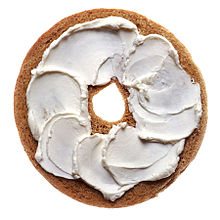Cream cheese
![]()
This article or subsequent section is not sufficiently supported by evidence (e.g., anecdotal evidence). Information without sufficient evidence may be removed in the near future. Please help Wikipedia by researching the information and adding good supporting evidence.
In Germany, double cream cheese (also Doppelrahmstufe) is the fat content level of cheese with a minimum of 60 and a maximum of 87 percent fat in the dry matter (Fett i. Tr., § 5 Käseverordnung). In Austria, cheeses with at least 55 percent fat in dry matter (F. i. T.) may be described as superfat and with at least 65 percent (F. i. T.) as double fat (§ 8 Milk Quality Ordinance). In Switzerland, double cream cheese has a fat content of at least 650 g/kg fat in dry matter (in the case of spreadable cheese, a dry matter of at least 530 g/kg cheese is specified, and in the case of spreadable cheese, at least 450 g/kg cheese) (Art. 52, Art. 62 VLtH).
Double cream cheeses thus usually have a very unobtrusive taste. They are odourless and soft and, provided they have not been modified by spices, taste sweetish-mild and occasionally a little acidic. Their ripening period is generally very short.
In the USA, cream cheese is a common fresh cheese. Double cream cheese is used in many ways, for example as a spread or for making cheesecakes.
Well-known double cream (fresh) cheeses are:
- Boursin, a French double cream cheese seasoned with garlic and herbs.
- Petit-suisse, a cream-enriched fresh cow's milk cheese
- Philadelphia (cream cheese), an American double cream cheese available worldwide.
Cheeses with a fat content of at least 75 percent in dry matter are sometimes referred to as triple cream cheeses. This term is a commercial designation derived from the French classification of cheeses such as Brillat-Savarin as triple crème. Legally, these cheeses are also considered double cream cheeses in Germany and Austria, and double fat in Switzerland.

Bagel with double cream cheese
Search within the encyclopedia